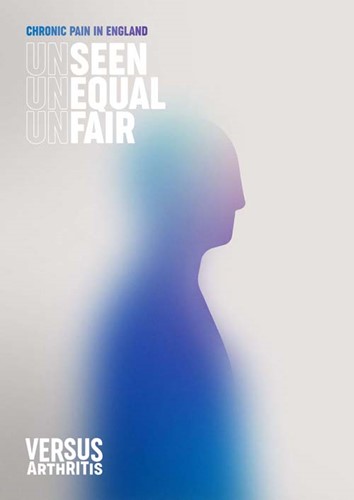A few years ago, Versus Arthritis funded the inclusion of a chronic pain questionnaire in the Health Survey for England. The findings from these questions are stark. Of great concern is that 5.5 million people in England (12% of the population) have high-impact chronic pain, the most severe form, which means a person struggles to take part in daily activities such as self-care, family, community and work.
Versus Arthritis’ new report, ‘Chronic pain in England: Unseen, unequal, unfair’ sets out key findings from the survey (initially analysed by Public Health England)  and a series of recommendations which call for a fundamental re-think in how we support people with chronic pain through far-reaching solutions.
and a series of recommendations which call for a fundamental re-think in how we support people with chronic pain through far-reaching solutions.
Musculoskeletal conditions such as osteoarthritis, back and neck pain, and fibromyalgia, are the most common cause of chronic pain and are the greatest cause of pain and disability in this country. About eight in every 10 people (84%) with chronic pain report that at least some of their chronic pain is in the neck or shoulder, back, limbs or extremities – all sites where pain is most likely to be musculoskeletal.
The same health inequalities that are seen in many long-term conditions are also seen in chronic pain. Adverse social and psychological experiences increase people’s risk of developing chronic pain. Groups that in our society experience greater life stress, disadvantage and discrimination are more likely to have chronic pain:
- Chronic pain is linked to deprivation. People who experience high-impact chronic pain are twice as likely to live in the most deprived areas (30%) compared to the least deprived areas (15%).
- Not only are women more likely to have chronic pain than men of the same age, but women also report more high-impact pain than men.
- There is an increased burden of chronic pain on people from some minority ethnic backgrounds. Black people are more likely to have chronic pain than people of other ethnicities. People with chronic pain who describe themselves as Asian are more likely to report high-impact pain than people of other backgrounds. These differences are likely due to the problems that people from some minority ethnic groups face in our society.
- Since 2011, the Health Survey for England also showed an alarming increase in high-impact chronic pain among young adults, which could change the life chances of a generation. In 2011, about two in every 10 people (21%) aged 16 to 34 years with chronic pain reported high-impact pain. This had increased to about three in every 10 people (32%) by 2017. We do not know why this has happened, or whether this upward trend will continue.
Visit the Versus Arthritis Chronic pain in England page to read more about the purpose of the report, the findings of the survey and what chronic pain means for the people that live with it.
